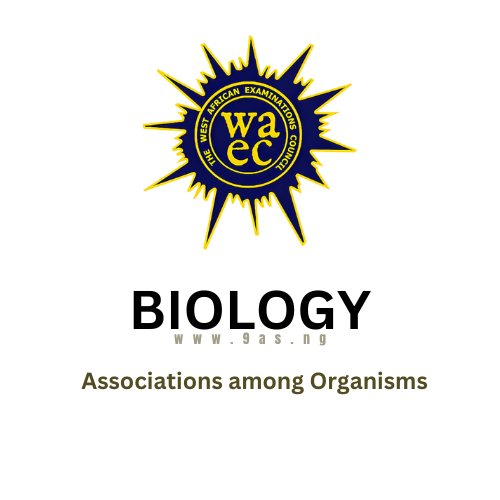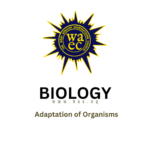OBJECTIVES
1. Squirrels easily kill some trees because
A. they inject poisonous substances into the trees. B. most trees are susceptible to squirrel bites. C. they feed voraciously on the roots. D. they gnaw the bark and destroy the phloem.
2. Which of the following organisms is an endo-parasite?
A. Tapeworm. B. Flea. C. Tick. D. Aphid.
3. Which of the following associations is an example of epiphytism?
A. Lice in the human hair. B. Mistletoe on citrus fruit. C. egret on cow. D. Fern on palm tree.
4. Which of the following organisms is an endo-parasite?
A. Mice. B. Mosquito. C. Ascaris. D. Dodder.
5. The association between two organisms in which one of the organism gains and the other loses is referred to as
A. saprophytism. B. commensalism. C. mutualism. D. parasitism.
6. Which of the following pairs of organisms is in a mutualistic relationship
A. Hydra and Sea anemone. B. Hermit crab and Sea anemone. C. Dodder plant and Cocoa plant. D. Mistletoe and Kolanut.
7. An association between living organisms in which one lives on and feeds at the expense of the other is known as
A. commensalism. B. predation. C. parasitism. D. mutualism.
8. Rhizobium which lives in the root nodules of leguminous plants is an example of the association known as
A. commensalism. B. epiphytism. C. mutualism. D. saprophytism.
9. Ascarislumbricoides is a parasitic
A. flat worm. B. round worm. C. arthropod. D. elastic worm.
10. Which of the following bacteria lives in the root nodules of leguminous plants?
A. Azotobacter. B. Nitrobacter. C. Rhizobium. D. Nitrosomonas.
11. Which of the following relationship does not involve two organisms?
A. Commensalism B. Saprophitism. C. Symbiosis. D. Parasitism.
12. What type of relationship exists between a tapeworm and an infected mammal?
A. Symbiosis. B. Commensalism. C. Predation. D. Parasitism.
13. What type of relationship exists in the large intestine of the sheep, between bacteria and the sheep?
A. Symbiosis. B. Commensalism.C. Predation. D. Parasitism.
14. The relationship between a herbivore and the bacteria which live in its caecum is known as
A. parasitism. B. symbiosis. C. commensalism. D. saprophytism.
15. In commensalism
A. one of the organisms gains and the other loses. B. both organisms benefit from the association. C. one of the organisms gains while the other neither gains nor loses. D. one of the organisms produces extra cellular digestive juices.
16. Parasitism can best be defined as an association between two organisms in which
A. both organisms benefit. B. one organism gains and the other neither gains nor lose. C. both organisms suffer some. D. one organism gains and the other loses.
17. The association between protozoa and termites is an example of
A. symbiosis. B. parasitism. C. predation. D. saprophytism.
18. Which of the following statements is not correct?
A. Ascaris living in the human gut illustrates parasitism. B. Rhizobium in the root nodules of legumesillustrates symbiosis. C. Bacteria in the gut of a termiteillustrates symbiosis. D. Mushroom growing on decayingwood illustrates parasitism.
19. Which of the following defines symbiosis?
A. parasitesfeed on dead organisms. B. both organisms benefit ofmutually by living together. C. Saprophytes feed onliving organisms. D. organisms serve as host to
parasite.
20. Which of the following organisms is not considered as
a parasitic plant
A. Cassytha. B. Rhizopus. C. Dodder. D. Mistletoe.
21. Which of the following associations can upset the
balance of nature?
A. Epiphitism. B. Parasitism. C. Symbiosis. D. Saprophytism
22. Which of the following organisms has a symbioticrelationship with green algae?
A. Amoeba. B. Paramecium. C. Hydra, D. Euglena
23. An association between two organisms in which bothbenefit is called
A. parasitism. B. commensalism. C. symbiosis. D. predation.
24. Which of the following characteristics is associatedwith commensalism?
A. Both organisms are harmful toeach other. B. The association involves many organisms. C. The association is beneficial to one of theorganisms. D. Both species are beneficial to each other.
25. A mutualism type of relationship is different from aparasitic relationship because in mutualism,
A. Bothorganisms involved benefit. B. None of the organisms benefits or harm each other. C. Both organisms harmeach other. D. Only one of the organisms is harmed.
26. An association between living organisms in which oneorganism lives on and feeds at the expense of theother organism is known as
A. mutualism. B.commensalism. C. parasitism. D. predation.
THEORY
1. (a) State two distinguishing features each of:
- epiphytes
- parasites.
(b) Give two examples of parasitic plants.
2. Explain briefly the relationship between three examples of symbiotic organisms
3. Give two examples each of
(a) saprophytes
(b) parasitic plants
4. Explain the terms:
(i) Parasitism,
(ii) Commensalism
5. (a) Classify the following biological associations under the headings in the table below:
(i) Remora and shark;
(ii)Lichen;
(iii) Cattle and white Egret;
(iv) Tapeworm in the gut of humans;
(v) Flowers and Honeybees;
(vi) Mistletoeand Cacao plant.
| Parasitism | Mutualism | Commensalism |
(b) (i) State three adaptive features of parasites.
(ii) State two effects of parasites on their hosts.
(c) (i) What aresaprophytes?
(ii) Give four examples of saprophytes.
6. Relationships I, II, III, IV and V exist among some organisms in an ecosystem. Use them to answer questions a to e
I: Organism A grows on dead organism B. a
II: Organism C feeds on the remnants of food left by organism D without affecting organism D negatively or positively.
III: Organism E provides shelter for organism F while organism F transports organism E towards food.
IV: Organism G kills organism B for food.
V: Organism H feeds on organism J, causing organism J a disease.
(a) Name the type of relationship in: I, II, III, IV and V.
(b) In relationship IV, what is the biological term for each oforganisms B and G?
(c) Name one example each of organisms B to J.
(d) (i) Name the relationship that is mostbeneficial to the ecosystem.
(ii) Give one reason for the answer in (d)(i).
(e) (i) Give two examples of organism A. (ii)
Name the group to which organism A belongs.



